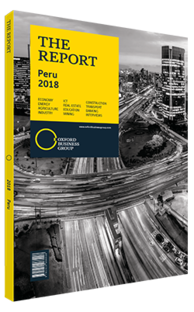CEOs positive about economic: prospects, despite adversity
In June 2018 the Central Reserve Bank of Peru (Banco Central de Reserva del Perú, BCRP) revised its 2019 growth outlook, forecasting GDP would expand by 4.2%. This represented a more optimistic view compared to its prediction of 4% in March 2018. The institution left its projection of 4% for 2018 unchanged. These figures reaffirm the sentiment expressed in the 2018 edition of the OBG Business Barometer: Peru CEO Survey: despite some challenges, economic prospects have been steadily improving since mid-2017.
The country experienced a number of obstacles in 2017. For one, the El Niño weather phenomenon resulted in substantial damage to coastal regions and lower-than-average agricultural output. In addition, the country is experiencing ongoing repercussions from the major corruption case involving Odebrecht – Brazil’s largest construction company – which caused delays in some key infrastructure projects.
The business environment eased somewhat as Peru moved into 2018: national infrastructure plans progressed under new public-private partnerships, construction recommenced on a variety of projects and commodity prices were once again on the rise, helping to boost the development of the mining and hydrocarbons industries.
However, some instability remained, particularly on the political front. After a series of corruption scandals and parliamentary crises, President Pedro Pablo Kuczynski stepped down in March 2018, moving his then-vice president, Martín Vizcarra Cornejo, into the presidential seat. This transition occurred relatively smoothly, and the business community received Vizcarra with open arms: politicians keep changing, challenges keep being faced and progress continues.
Buoyant Despite Volatility
Evidently, Peru is dynamic and capable of growth – a necessary strength for any emerging market – even with a certain degree of instability. As seen in OBG’s most recent CEO survey as well as previous ones, the confidence of the domestic private sector is resilient.
Results from the survey show that 84% of respondents had positive or very positive expectations of local business conditions for the coming 12 months. Furthermore, not a single participant in our face-to-face survey reported having a very negative outlook for the year ahead. While this represents overwhelmingly positive sentiment among executives, this is marginally lower than the 89% who had positive or very positive expectations in our previous Peru CEO Survey, which was published in December 2017.
In terms of intentions to invest, our findings show that the numbers have risen slightly since the survey’s previous iteration, when 58% of CEOs were planning on making a significant capital investment in the next 12 months. In the 2018 survey the figure sits at 60%.
These optimistic outlooks appear to be well founded: according to consultancy firm Thorne & Associates, private investment levels experienced around 7% growth between April and May 2018. Meanwhile, mining saw expansion of nearly 50% in this period, contributing further to an already promising year for the primary sector.
Our results help explain some of the reasoning behind the BCRP’s positive GDP growth projections, as well as Peru’s robust economic performance in 2017 and 2018 – in April 2018 the country recorded year-on-year growth of 6%. This is in part due to the financial sector’s solid foundations and reliable regulations, with these appearing to work well in practice: 71% of respondents considered access to credit to be easy (52%) or very easy (19%).
Further Development Potential
Although Peru has withstood considerable adversities, there is, as always, room for improvement. Notably, the private sector continues to demand that more is done to fight against corruption – politicians, businesspeople and judges have been found to be involved in illicit activities in recent years. As many as 71% of respondents to our survey said that government efforts in this regard were insufficient or very insufficient.
President Vizcarra, being new to office, has not yet earned the trust of the entire business community, but he has taken every opportunity to affirm that his government will fight drug trafficking and corruption, regardless of who may be involved. During his visit to the triple border area with Ecuador and Colombia in July 2018 he announced an imminent reform on the judicial system to prevent corruption in justice.
In terms of human capital, the plurality (33%) of business players consider leadership as the skill in greatest need in the local labour market, which is a common result among many of the emerging countries that we survey.
Reducing the country’s dependency on commodities would also lead to more sustainable growth. Although the prices of minerals and hydrocarbons have largely contributed to the expansion of the energy sector, they also generate volatility in the longer term. CEOs are aware of this caveat, with 57% of participants citing low commodity prices as the top external event that could impact the local economy in the near term, highlighting a need for greater investment in value-added industries. The next-most-popular choice was a possible slowdown of the Chinese economy (19%), which demonstrates Peru’s increasing dependence on Asian markets.
In 2018 Peru is enjoying a more favourable global environment for its mining and hydrocarbons sectors. However, manufacturing, fishing and construction are continuing to lead growth and could prove to be more reliable in the longer term. Other challenges persist, such as increasing poverty rates and high levels of regional inequality, which were increased by El Niño and the resulting ongoing reconstruction efforts. Despite these factors, the Andean country’s optimistic private sector appears to be more active than ever.
You have reached the limit of premium articles you can view for free.
Choose from the options below to purchase print or digital editions of our Reports. You can also purchase a website subscription giving you unlimited access to all of our Reports online for 12 months.
If you have already purchased this Report or have a website subscription, please login to continue.

